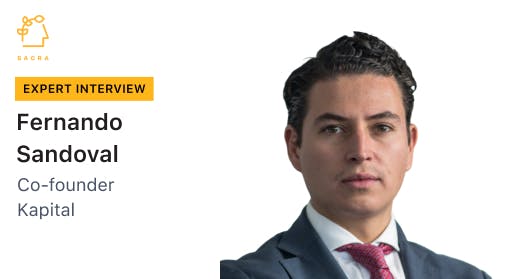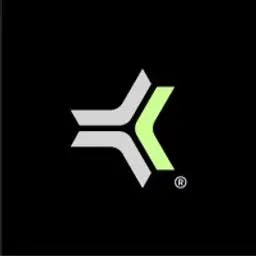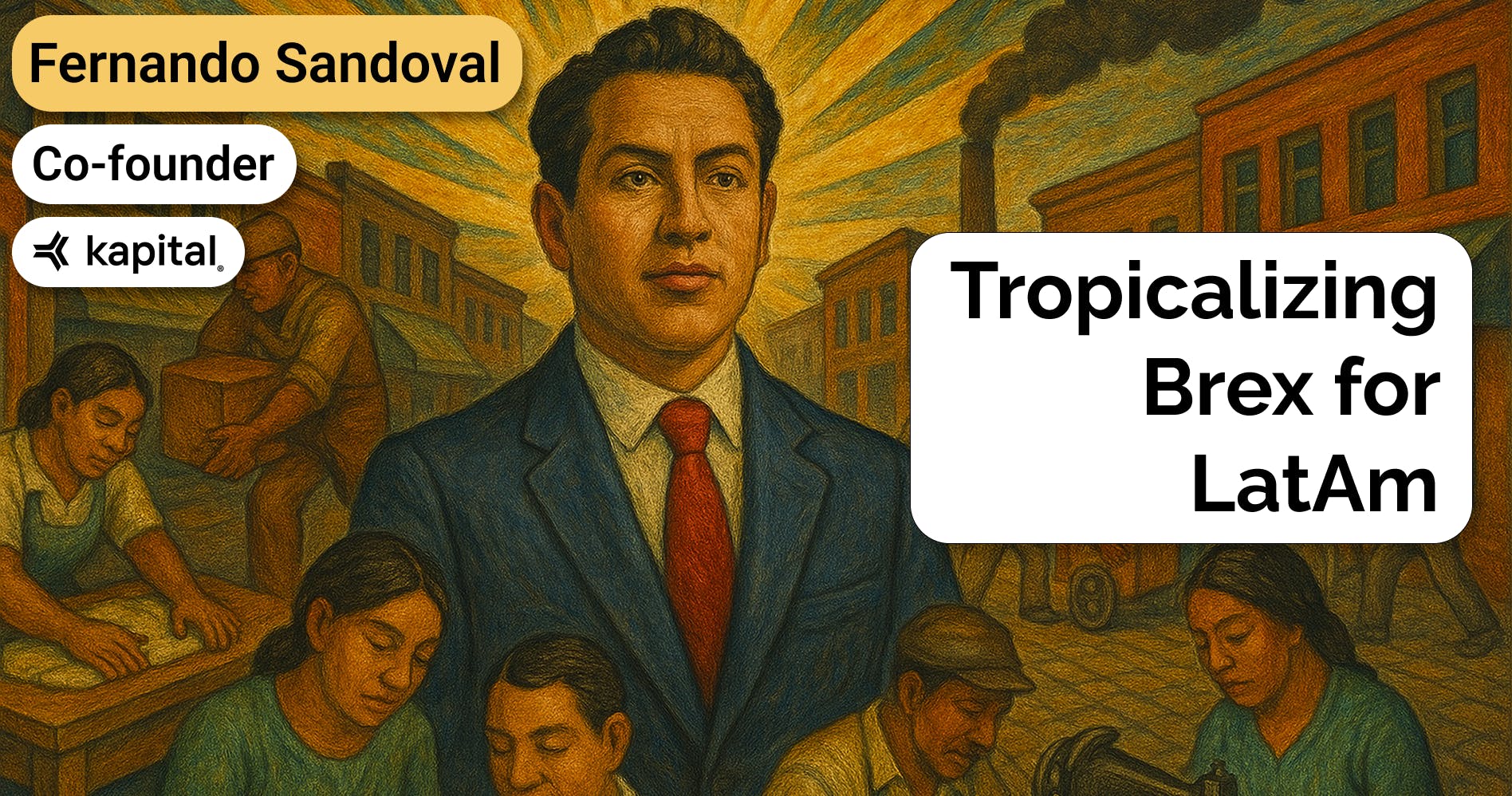Fernando Sandoval, co-founder of Kapital, on stablecoins for cross-border payments
 Jan-Erik Asplund
Jan-Erik Asplund

Background
Fernando Sandoval is CFO and co-founder at Kapital. We talked to Fernando about Kapital's stablecoin treasury management product and their use of stablecoins as payment rails for cross-border transactions, why Latin America is emerging as a key geography for stablecoin adoption, and how stablecoins enable insurgent international neobanks to build novel fintech offerings as they counter-position against incumbent banks.
Questions
- There's two basic types of stablecoin products in the Kapital context: the customer-facing stablecoins that SMEs want to hold their funds in, and the infrastructure use case where Kapital uses stablecoins on the backend to facilitate money transfers. Let's start with the customer-facing use case. Can you walk us through an example of how SMEs access and use stablecoins on Kapital? How does it differ from the traditional FX experience?
- Kapital launched a product that lets SMEs deposit their funds into Kapital and get access to stablecoins alongside local currency. What are you seeing on the demand side?
- Within the stablecoin market in LatAm, are you seeing any particular coin winning out? Which coins does Kapital use and how do you think about de-risking?
- Does being an international neobank, based in LatAm, give Kapital an advantage in using stablecoins?
- Can you walk us through an end-to-end example of the internal Kapital use case where you're using stablecoins to do a money transfer?
- Stablecoins seem to provide a significant cost advantage over traditional cross-border payment rails. What are the typical fees Kapital pays in basis points to transfer stablecoins, and how does that compare to the fees you would incur for fiat currency transfers of comparable amounts?
- We previously discussed Kapital's multi-product strategy of launching banking, cards, lending, payroll, bill pay, etc. Where do stablecoins fit into that product strategy? What are the new use cases or products you can uniquely enable by having stablecoins as a payment rail?
- What are the open problems or infrastructure gaps around stablecoins that still need to be solved to make them a ubiquitous payment rail, on par with cards or bank transfers today? Are there any areas where Kapital is investing in building new technology or partnering with other players in the ecosystem to help solve those gaps?
- Many fintechs and neobanks in the US partner with banking-as-a-service providers and sponsor banks rather than obtaining their own bank charter. Kapital took the less common approach of acquiring a bank license in Mexico. What was the rationale for becoming a fully licensed bank, and how does that impact your ability to use stablecoins as a payment rail?
Interview
There's two basic types of stablecoin products in the Kapital context: the customer-facing stablecoins that SMEs want to hold their funds in, and the infrastructure use case where Kapital uses stablecoins on the backend to facilitate money transfers. Let's start with the customer-facing use case. Can you walk us through an example of how SMEs access and use stablecoins on Kapital? How does it differ from the traditional FX experience?
As you know, in Latin America, region-by-region, it’s unstable. It's not as stable as the US or Europe or Japan. Usually every time the government changes, the currency of each country has fluctuations.
The problem that we identified was that for companies, it was really hard to get access to American dollars or to a strong currency to protect against that fluctuation and depreciation.
Our solution was to offer a crypto wallet paired with a card that allows companies to store funds in a stablecoin like USDC. This exists alongside their local currency accounts, providing a way to safeguard a portion of their treasury against volatility. The crypto card can then be used for purchase anything from restaurants to flights while drawing from the stable stablecoin balance.
This is a highly valuable use case for our customers in countries like Colombia where the peso has swung from 3,200 to 5,000 to 3,800 per USD in a short period. The Mexican peso fluctuated from 19 to 25 to 17 per USD during Covid. By having exposure to a stable digital currency like USDC, companies can get access to a stronger currency that is more stable so they can protect the treasury of their company.
Kapital launched a product that lets SMEs deposit their funds into Kapital and get access to stablecoins alongside local currency. What are you seeing on the demand side?
The demand is really good. Whenever we onboard a customer, we offer that product, and almost everyone takes it because it is giving access right away to dollars. So the answer we get is, "Why not?"
Usually with legacy banks, our customers don't have access to stablecoins that easily.
Within the stablecoin market in LatAm, are you seeing any particular coin winning out? Which coins does Kapital use and how do you think about de-risking?
USDC is the main one in terms of its regulatory and transparency features. And we chose that one because it's the strongest in LatAm. Again, this is for companies.
Consumer is different because they can speculate. From a company perspective, it's way different. You don't want to risk the company buying and selling crypto. That's not the focus.
Of course, some can do it, but the business has a purpose and you need to focus on the purpose. You can maximize profit by minimizing risk. And that's how we stepped in with the crypto card.
Does being an international neobank, based in LatAm, give Kapital an advantage in using stablecoins?
Yes, because we are playing as a local. It's very different when you are local, and it gives you a strong edge.
Kapital is a bank in Mexico, and as our main focus is B2B, our currency is trust. You provide trust to a customer first with product, second with service, and third with a permit you have that protects you. It is not the same to be a fintech without a permit, or with a different permit that doesn’t give you the strongest capacity to run and do business.
Can you walk us through an end-to-end example of the internal Kapital use case where you're using stablecoins to do a money transfer?
Crypto can also strengthen cross-border transactions. We have a really strong product called Kapital Flex for confirming or reverse factoring. One major issue we identified for SMBs is lack of cash flow control. Typically, they sell to large corporate customers like Kraft, Coca-Cola, Walmart etc. who can dictate payment terms of 120 days or more. The SMB keeps selling but eventually runs out of working capital as receivables pile up.
With Kapital Flex, we help SMBs organize and control cash flow by providing a credit facility to pay vendors directly instead of waiting to get paid by their customers. The cool part is this facility can be used to make international vendor payments as well.
Say a Colombian or Mexican company needs to pay a Chinese supplier for inventory. Kapital pays the vendor upfront, while the company pays us back in installments from their incoming sales. It's like "buy now, pay later" but for businesses rather than consumers. This allows the SMB to access inventory immediately while smoothing cash outflows. Crypto comes into play for executing the cross-border payment to the vendor seamlessly.
So in essence, Kapital Flex combats cash flow issues using our credit facility, while crypto enables efficient international payments - giving SMBs the liquidity to operate and grow.
Stablecoins seem to provide a significant cost advantage over traditional cross-border payment rails. What are the typical fees Kapital pays in basis points to transfer stablecoins, and how does that compare to the fees you would incur for fiat currency transfers of comparable amounts?
That's a great question. So first of all, the answer is it depends if it's B2C or B2B. And why? Because the pricing also always varies according to the volume you operate in both markets. If you're exchanging currencies at a legacy bank with a traditional B2C model, imagine exchanging US dollars for Mexican pesos. They may purchase dollars from you at a rate of 15.65 pesos per dollar, but then sell you dollars at a rate of 17.05 pesos per dollar. So the spread, or difference between the buy and sell rates, is 1.4 pesos. It's a massive spread, making the transaction way, way more expensive than necessary. That's just for a typical B2C exchange—and that's why a crypto exchange makes sense by providing a cheaper solution.
Of course, there are other legacy banks, brokerage houses, or foreign exchange (FX) specialists that provide better FX rates. They focus specifically on currency exchange, and their spreads are much tighter. In general, exchanging foreign currencies is cheaper when dealing with higher volumes through FX specialists rather than retail banks.
We previously discussed Kapital's multi-product strategy of launching banking, cards, lending, payroll, bill pay, etc. Where do stablecoins fit into that product strategy? What are the new use cases or products you can uniquely enable by having stablecoins as a payment rail?
I think after the recent "crypto winter" or downturn in the cryptocurrency markets, crypto is starting to make a comeback and is here to stay long-term. That's the truth. However, the adoption and regulation of crypto is going to vary across different regions, with each government regulating crypto products in their own way according to their policies. It's not just about being able to trade cryptocurrencies and hold the money - you now also need the capability to actually use it for payments and transactions.
We're starting to see crypto being used for payment methods and as a store of value like the crypto investment product we offer.
This is due to the crypto card we offer, which is how we give customers the capacity to use stablecoins as a payment method.
It's also being used for cross-border payments and money transfers from different angles. But the crypto industry is still evolving rapidly and will continue to keep evolving.
What are the open problems or infrastructure gaps around stablecoins that still need to be solved to make them a ubiquitous payment rail, on par with cards or bank transfers today? Are there any areas where Kapital is investing in building new technology or partnering with other players in the ecosystem to help solve those gaps?
The main issue is adoption across regions, but that's moving really fast. You're opening new regions over and over. But again, it depends on regulation. Nigeria is a really hard country to get approved in, but there are countries that are way more open. Argentina is also a mess to operate in. So it depends. But everything is about adoption. Like in El Salvador, the president declared crypto a national currency. So again, you have different positions across regions. A lot of regulation is happening right now in this space.
Many fintechs and neobanks in the US partner with banking-as-a-service providers and sponsor banks rather than obtaining their own bank charter. Kapital took the less common approach of acquiring a bank license in Mexico. What was the rationale for becoming a fully licensed bank, and how does that impact your ability to use stablecoins as a payment rail?
The good thing is right now we're a bank, so if new regulation comes along, the banks are going to be the winners. Before we were a bank, it was the opposite situation. But that's why we think, and our vision is, the fintech world is going to be regulated sooner or later—it always happens. If you analyze the history of finance, it's a pendulum. They open up and allow a lot of different permits and you can do all sorts of stuff. And then the regulator starts regulating, regulating, regulating again, and it controls the bubble. This cycle comes and goes, comes and goes.
Disclaimers
This transcript is for information purposes only and does not constitute advice of any type or trade recommendation and should not form the basis of any investment decision. Sacra accepts no liability for the transcript or for any errors, omissions or inaccuracies in respect of it. The views of the experts expressed in the transcript are those of the experts and they are not endorsed by, nor do they represent the opinion of Sacra. Sacra reserves all copyright, intellectual property rights in the transcript. Any modification, copying, displaying, distributing, transmitting, publishing, licensing, creating derivative works from, or selling any transcript is strictly prohibited.
















